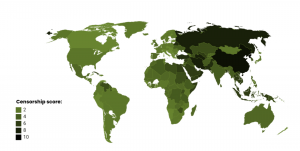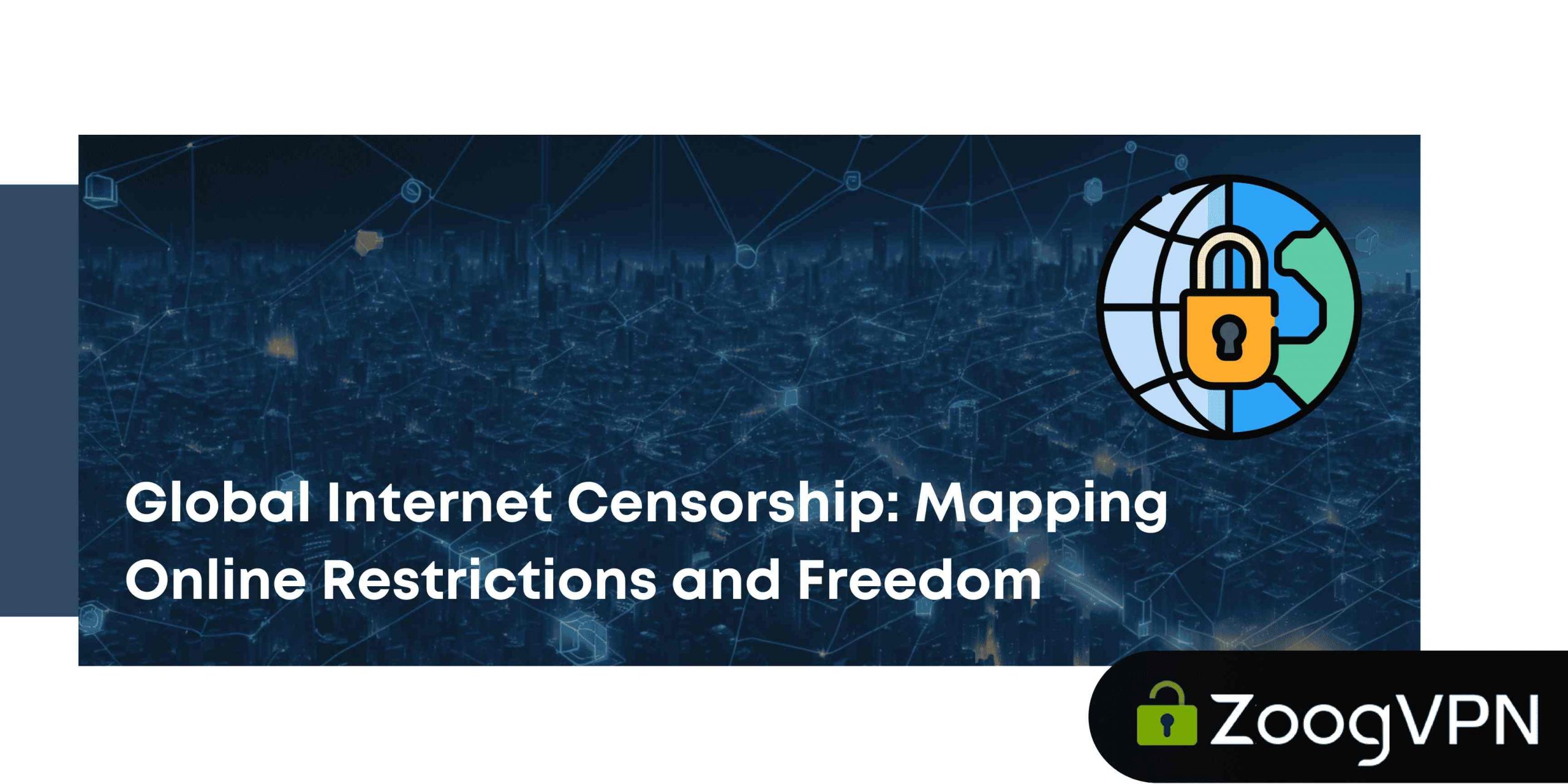Ever tried watching your favorite video only to find it blocked, like the internet itself is playing a prank on you? But in some parts of the world, censorship isn’t just an inconvenience but a serious barrier to information and free expression.
With over 5.52 billion people online, about 67.5% of the world’s population, the Internet is the all-around hub for everything, from your favorite memes to breaking news, from keeping up with friends to binging shows about people who drink too much coffee. But here’s the core point: not all of us get the same internet experience. In some countries, just opening Twitter or downloading a file requires more effort than solving a Rubik’s cube blindfolded.
So, what’s the deal? How much of the internet are we actually allowed to see? And who decides? Let’s break it down in this post.
The Framework of Internet Censorship
To get a clear picture of global internet censorship, we took a deep dive into six key areas where restrictions hit the hardest. The more a country clamps down in each category, the tighter its grip on the internet. So, let’s break it down and see which governments are going all-in on digital control.
Torrenting
Ever tried to download a movie, only to find your favorite torrent site mysteriously unavailable? That’s because many governments are cracking down on file sharing, blocking access through internet service providers (ISPs) or even going as far as prosecuting users. Some countries take a strict legal approach, while others just make torrenting an inconvenient guessing game of “which site still works today?”
Online Pornography
Adult content regulations are all over the place – some countries enforce light restrictions like age verification pop-ups, while others go full-scale censorship, banning everything outright. In extreme cases, just trying to access adult content could land you in legal trouble. Whether it’s soft filtering or a total blackout, one thing is clear: governments are keeping a close eye on what’s allowed on-screen.
Political Media
Open political discussion is the backbone of democracy, but not every government is a fan of free speech. Some block independent news sources, censor criticism, and silence opposing views before they even gain traction. In the worst cases, entire media outlets get shut down, leaving citizens with only state-approved narratives. When the only news you get is government-approved, how free is the internet, really?
Social Media
Platforms like Facebook, Instagram, and X (formerly Twitter) have become digital battlegrounds for activism, free speech, and uncensored news. That’s exactly why some governments restrict or completely ban them. Whether they block only certain content or take the nuclear option by shutting down entire platforms, these restrictions put serious limits on how people connect, share, and organize online.
VPN Usage
A VPN (Virtual Private Network) is one of the best, tried-and-true tools, letting users sidestep censorship and access blocked content. But not all countries allow users to circumvent their restrictions. Put in practice, some regions regulate VPNs by requiring providers to register with authorities (which kind of defeats the purpose), while others go all in – banning them completely and penalizing both users and companies that offer them.
Messaging and VoIP Apps
Apps like WhatsApp, Signal, and Skype make global communication simple and secure. But certain governments see them as a threat and either restrict access or push state-controlled alternatives that let them monitor conversations. If your go-to messaging app suddenly stops working, it’s probably not a glitch but a censorship at play.
The Most Censored Countries
For millions, unrestricted internet access is still a dream. Our digital world keeps expanding, with government censorship, poor infrastructure, and strict regulations keeping large populations disconnected. In many places, controlling the internet is just another way for authorities to control people.
Today, 35% of internet users worldwide face heavy restrictions, with North Korea standing as the most extreme illustration of total digital isolation. Whereas, Southern Asia remains the region with the highest number of people still unconnected to the web.
North Korea, China, and Iran
These three take internet censorship to the extreme, turning the web into a tightly controlled space where the government decides what people can and can’t see. North Korea is in a league of its own – regular citizens don’t even get real internet. Instead, they’re stuck with a government-run intranet called “Kwangmyong,” which is basically a walled-off, propaganda-filled version of the web. In China, global platforms like Facebook, Twitter, and YouTube are completely off-limits, forcing people to use highly monitored alternatives like WeChat and Weibo. Iran follows a similar playbook, keeping a close eye on internet users and blocking Western social media altogether. These three countries impose the highest level of restrictions, effectively cutting their people off from the open internet.
Turkmenistan, Myanmar, and Russia
Not far behind, these countries are also making sure their citizens don’t get too comfortable online. In Turkmenistan, trying to access independent media is nearly impossible, and VPNs – which people use to get around censorship – are constantly being blocked. Myanmar has a track record of straight-up shutting down the internet whenever political unrest flares up, while also slapping tight restrictions on social media. Russia has been ramping up its internet control lately, banning VPNs, cracking down on independent news sites, and blacklisting platforms like Facebook and Instagram.
Saudi Arabia, Egypt, and the United Arab Emirates
These countries may not go all-in on total censorship, but they still keep a tight grip on online activity. Saudi Arabia and the UAE technically allow VPNs, but don’t think that means free internet – usage is closely watched. Meanwhile, Egypt has stepped up its game by blocking torrenting sites and restricting adult content, even though data shows a huge demand for it. Across all three, social media monitoring is a big deal, and authorities don’t hesitate to crack down on content they don’t like.

Source: Global Freedom of Expression
Internet Censorship by Region
Now, let’s overview the censorship levels in countries and regions below.
Europe
While Europe generally has more internet freedom, it’s not without its restrictions. 21 countries have banned or blocked torrenting sites, while another 21 have placed restrictions without fully enforcing them. For example, Spain technically bans torrenting but allows personal use in some cases. Porn laws are also getting stricter – Belarus has a full ban, while Lithuania, Turkey, and Ukraine have partial restrictions. France, the UK, and Germany recently introduced mandatory age-verification systems for adult content.
Political censorship is alive and well, too. 21 European countries impose restrictions on political media, with Belarus and Turkey leading the pack. In Belarus, thousands have been penalized for their online activity, while Turkey actively monitors social media and even encrypted messaging apps. VPN usage is restricted in both countries, and Spain briefly tried to suspend Telegram in 2024 for failing to comply with court orders.
Asia
Asia is home to some of the strictest internet controls on the planet. China is the most infamous, but it’s not alone – Pakistan, Iraq, and Vietnam also have serious restrictions in place. In Vietnam, the government keeps a close eye on social media, cracking down on anyone who criticizes them. Even India, known for being a democracy, shuts down the internet during protests, especially in Jammu and Kashmir.
When it comes to porn, the region is overwhelmingly restrictive – 42 out of 49 countries block access, and many have laws against using VPNs to get around the bans. Speaking of VPNs, seven countries – including China, Iran, and North Korea – outright ban them, while 14 others impose heavy restrictions. Russia has been ramping up its efforts, adding more VPN services to its blacklist in late 2023 and increasing penalties for anyone caught using or promoting them. Meanwhile, 29 countries limit access to social media, with nine even going as far as shutting down platforms entirely when they feel like it. Messaging apps and VoIP services aren’t safe either – restrictions exist in 23 countries, and Israel limits Palestinian access to technology and VoIP communication.
North America
North America isn’t as locked down as other regions, but censorship still exists. The U.S. and Canada have banned torrenting sites, while Trinidad and Tobago take it a step further by enforcing harsh penalties for illegal streaming. Several U.S. states – including Arkansas, Texas, and Virginia – have passed age-verification laws for porn.
Political media censorship is mostly limited to Cuba, Nicaragua, Honduras, and Guatemala, where governments heavily suppress dissenting voices. In Mexico and El Salvador, journalists face constant threats, and at least five Mexican journalists have been killed since January 2024. Cuba is the most restrictive country in the region – it’s the only one that outright bans VPNs, and it also limits access to WhatsApp and Telegram. Government surveillance is widespread, particularly in Cuba and Nicaragua, where social media monitoring is systematic.
South America
Internet censorship in South America varies by country. Argentina, Brazil, Ecuador, Peru, and Uruguay have blocked torrenting sites, and some others enforce restrictions without outright bans. Surprisingly, Venezuela is the only country in the region that restricts porn access.
Political censorship is a major issue, especially in Ecuador, Colombia, and Paraguay, where journalists face serious threats. Colombia alone saw two journalists killed in 2024. In Venezuela, social media is tightly monitored, and people have even been arrested for things they’ve said on WhatsApp. Brazil has also stepped up its censorship efforts, blocking social media content and pushing anti-“fake news” measures. Venezuela remains the only country in South America with a complete VPN ban, while Brazil and Suriname have joined Venezuela in restricting access to messaging apps like Telegram.
Africa
Censorship is widespread across Africa, with Egypt, Sudan, Nigeria, and South Africa leading the way in blocking torrenting sites. When it comes to porn, 23 African countries impose restrictions, and 11 have outright bans, including Uganda and Ethiopia.
News media is heavily censored in 25 African nations, with Seychelles, Benin, and Botswana standing out as some of the few places where press freedom still exists. Social media restrictions are even more common – 38 countries enforce limitations, though Eritrea is the only one with a full, continuous block on social platforms. Government surveillance of social media happens in 44 countries, making Africa one of the most monitored regions in the world. VPNs are restricted in Egypt, Sudan, and Uganda, while Skype, WhatsApp, and other messaging apps are banned or limited in 12 countries. However, Morocco recently lifted its VoIP bans, making it a rare exception.
Oceania
Censorship is much lighter in Oceania, but it still exists. Australia and New Zealand are the only two countries that have banned torrenting sites. Meanwhile, Papua New Guinea takes an unusual approach to porn restrictions – it’s illegal to possess adult content, but people can still access it online without issues.
Political censorship is most noticeable in Fiji, Tonga, and Papua New Guinea, where governments keep a close watch on online activity. Australia recently introduced a controversial ban on social media for anyone under 16, sparking debate over internet freedom. Fiji has also warned its citizens not to post anything that goes against local laws.
Unlike other regions, Oceania doesn’t restrict VPNs or messaging apps, making it one of the more internet-friendly areas in the world.
| Country | VPNs Restricted | VPNs Banned? | Messaging and VoIP App Restrictions | Political Media Heavily Censored? | Social Media Restricted? |
|---|---|---|---|---|---|
| China | Y | Y | Y | Y | Y |
| North Korea | Y | Y | Y | Y | Y |
| Russia | Y | N | N | Y | Y |
| Iran | Y | N | Y | Y | Y |
| UAE | Y | Y | Y | Y | Y |
| Turkey | Y | N | Y | Y | Y |
| Saudi Arabia | Y | Y | N | Y | Y |
| Syria | Y | N | Y | Y | Y |
| Vietnam | Y | N | Y | Y | Y |
| Myanmar (Burma) | Y | Y | Y | Y | Y |
| Cuba | Y | N | Y | Y | Y |
| Belarus | Y | N | N | Y | Y |
175 Countries Censorship Overview
Growing Trends in Internet Censorship
Internet censorship has gotten more aggressive and sophisticated over the last decade. In 2024 alone, nearly 60 countries rolled out new restrictions, proving that online freedom is under constant attack. Social media platforms remain a major target as governments try to control public opinion. Meanwhile, age verification laws for adult content are appearing across Western democracies, showing that even freer societies are tightening their grip on internet access.
What is the of the most worrying trends? Criminalizing VPN use. VPNs have long been a lifeline for people dodging censorship, but governments like Russia and China are doubling down on blocking them. With fewer options to bypass restrictions, many internet users are feeling increasingly trapped behind their countries’ digital firewalls.
How Governments Use Technology for Censorship
Governments have gotten crafty, using high-tech tools to monitor and control online activity. Here’s a breakdown of some of the biggest censorship tactics in play today:
AI-Powered Surveillance
Artificial intelligence is the backbone of modern censorship systems. Machine learning tools can scan massive amounts of data in real time, flagging keywords, images, or trends that governments don’t like. In places like China, AI actively scans social media platforms like WeChat, blocking any post that criticizes the government or brings up “taboo” topics like Tiananmen Square or human rights violations.
Deep Packet Inspection (DPI)
DPI technology is next-level snooping. It doesn’t just track basic metadata; it analyzes actual internet traffic – meaning authorities can see exactly what websites people are visiting, what messages they’re sending, and even how they’re trying to get around restrictions. Russia and Iran use DPI to block encrypted communication, throttle VPNs, and shut down censorship-circumventing tools.
Content Filtering & Blacklists
Governments maintain huge blacklists of banned websites, apps, and online services. Content filtering tools then use these lists to automatically block access. Some systems go even further, censoring specific keywords, hashtags, or memes if they start gaining traction. For example, Turkey doesn’t just block entire news sites; it has even banned specific tweets critical of the government.
Geofencing & Geo-Blocking
By working directly with internet service providers (ISPs), governments can limit access to certain platforms based on a user’s location. Countries like North Korea and Turkmenistan take this to the extreme by allowing only a state-controlled intranet, cutting their citizens off from the global web almost entirely.
Facial Recognition & Biometric Monitoring
In some places, online censorship is now tied to real-world surveillance. China is leading the charge, forcing users to link their social media accounts to their national IDs and using AI-driven facial recognition to track people’s behavior both online and in public spaces. This fusion of digital and physical surveillance creates a chilling effect – people are afraid to say anything critical, whether online or in person.
Tools for Resisting Censorship
For every censorship tactic, there’s a countermeasure. Tech-savvy users and activists continue to come up with the new ways to fight back. Here’s how people are resisting digital oppression:
Encrypted Messaging Apps
Apps like Signal, Telegram, and WhatsApp have become lifelines for people in censored countries. Thanks to end-to-end encryption, messages are scrambled so only the sender and receiver can read them – making it almost impossible for governments to eavesdrop. Of course, authorities fight back – Iran, China, and Russia have tried to block or restrict access to these apps altogether.
Virtual Private Networks (VPNs)
VPNs are still one of the best tools for circumventing censorship. They encrypt internet traffic and route it through servers in other countries, helping users get around government firewalls while staying anonymous. But many countries, including Russia and China, have intensified efforts to block or regulate VPNs, either by targeting known VPN servers or forcing users to register their identities.
ZoogVPN offers a powerful solution with its Shadow protocol, designed specifically to eliminate censorship in these restrictive regions. It brings much more benefits than traditional services; ZoogVPN combines VPN encryption with proxy technology, making it harder for authorities to detect and block. It adheres to a no-logs policy, ensures the fastest speeds, and provides reliable servers, facilitating secure and unrestricted internet access anywhere.
Tor & Onion Routing
The Tor network is a game-changer for online anonymity. By routing internet traffic through a series of volunteer-operated servers worldwide, it makes it nearly impossible to trace users or block specific content. Iran and Myanmar are among the many places where people rely on Tor to access restricted websites and communicate securely. Naturally, governments are fighting back – China has tried blocking Tor nodes to cut off access.
Decentralized Platforms
Blockchain technology is offering new ways to bypass censorship. Unlike traditional websites that rely on centralized servers, decentralized platforms spread data across a global network of nodes. This means no single government or company can take them down. Projects like IPFS (InterPlanetary File System) and Mastodon are leading the way in building censorship-resistant networks.
Blockchain-Based DNS
Another blockchain innovation: censorship-proof domain name systems (DNS). Traditional DNS services are controlled by governments or corporations, meaning they can be easily blocked or manipulated. Blockchain-based DNS, on the other hand, distributes domain records across a decentralized ledger, making them virtually impossible to shut down.
Peer-to-Peer (P2P) Networks
P2P networks let people share files and information directly, without relying on centralized servers that can be censored. This is a crucial workaround in places with strict censorship laws, allowing users to circulate news, videos, and other content that would otherwise be banned.
A Fight for the Future of the Internet
As online restrictions multiply, it’s clear that censorship is no longer exclusive to authoritarian regimes. Even democratic nations are tightening their borders on internet usage, often under the guise of security or moral protection. This trend raises urgent questions about the future of online freedom.
While tools like VPNs and encrypted platforms provide hope, their growing criminalization in some parts of the world is a troubling sign. If left unchecked, the internet – once a symbol of free expression – could turn into a heavily regulated space dictated by government interests.
ZoogVPN as Your Gateway to an Open Internet
In a world where censorship keeps getting worse, ZoogVPN is here to keep your internet truly free. No matter where you are, ZoogVPN lets you cope with even the toughest restrictions and surf the web without limits.
What Makes ZoogVPN Different?
It all comes down to the Shadow Protocol – a next-level solution that disguises VPN traffic as regular HTTPS one. The protocol makes it nearly impossible for governments to detect and block, even in highly restricted areas like China, Russia, Iran, and the UAE. With advanced encryption and obfuscation, ZoogVPN ensures that even the most powerful firewalls and DPI (deep packet inspection) systems can’t stop you from accessing the open web.
Why You Need ZoogVPN
- Break through firewalls – Are you’re in China, Qatar, Russia, or the UAE? ZoogVPN gets past ISP blocks and government restrictions effortlessly.
- Stay private & secure – Your data is fully encrypted, keeping it away from prying eyes—including hackers, ISPs, and government surveillance.
- Super easy to use – ZoogVPN’s apps are simple and user-friendly, so you can connect in seconds. Plus, 24/7 customer support has your back if you ever run into issues.
- Unblock the world – Whether it’s news, social media, or entertainment, ZoogVPN keeps the internet open – no matter where you are.
Censorship is growing, but that doesn’t mean you have to accept it. With ZoogVPN and the Shadow Protocol, you can unlock websites, access global content, and communicate freely – despite how restrictive your location is.
The internet should be a place of freedom, not control. Don’t let governments decide what you can or can’t see. Start using ZoogVPN today and regain your online freedom.
Your digital freedom starts with ZoogVPN. Try today!

























